Search Result
Results for "
muscle-relaxant
" in MedChemExpress (MCE) Product Catalog:
11
Isotope-Labeled Compounds
| Cat. No. |
Product Name |
Target |
Research Areas |
Chemical Structure |
-
- HY-W052144
-
-

-
- HY-101237
-
-
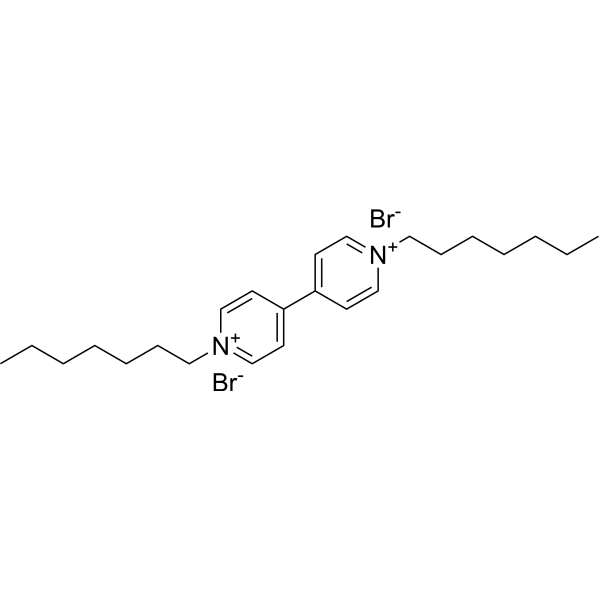
-
- HY-B1283
-
-
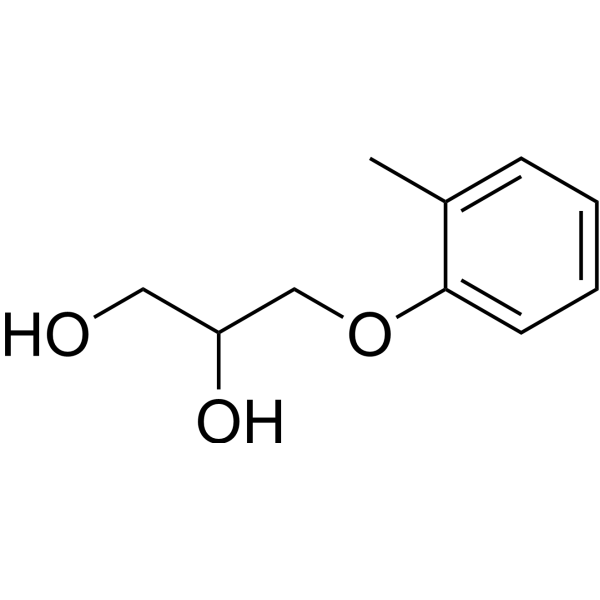
-
- HY-B1230
-
-
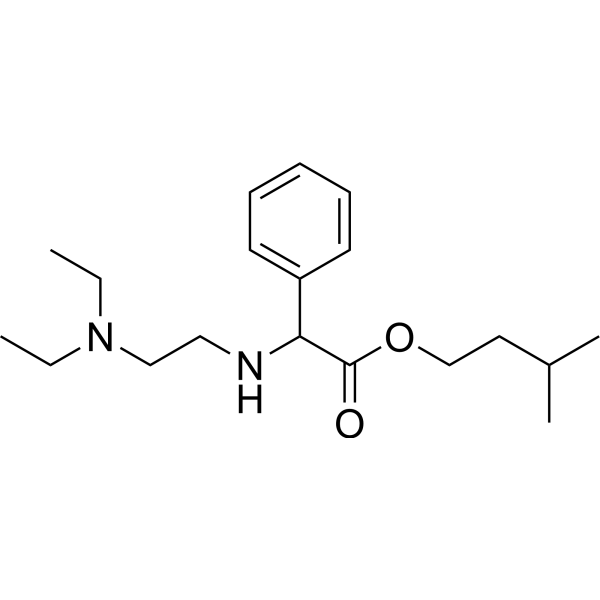
-
- HY-100159
-
-
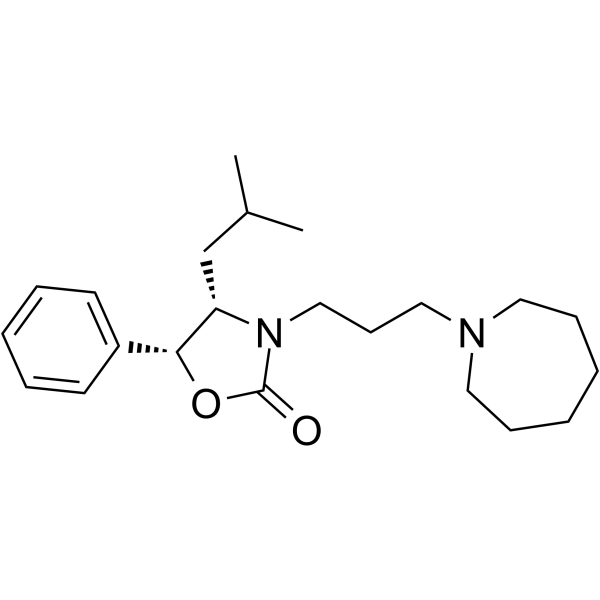
-
- HY-B0740
-
|
MK130 hydrochloride
|
5-HT Receptor
|
Neurological Disease
|
|
Cyclobenzaprine hydrochloride (MK130 hydrochloride) is a skeletal muscle relaxant and a central nervous system (CNS) depressant.
|
-

-
- HY-121340
-
|
|
Others
|
Neurological Disease
|
|
Emylcamate is a potent muscle relaxant. Emylcamate has the potential for the research of neurological diseases .
|
-
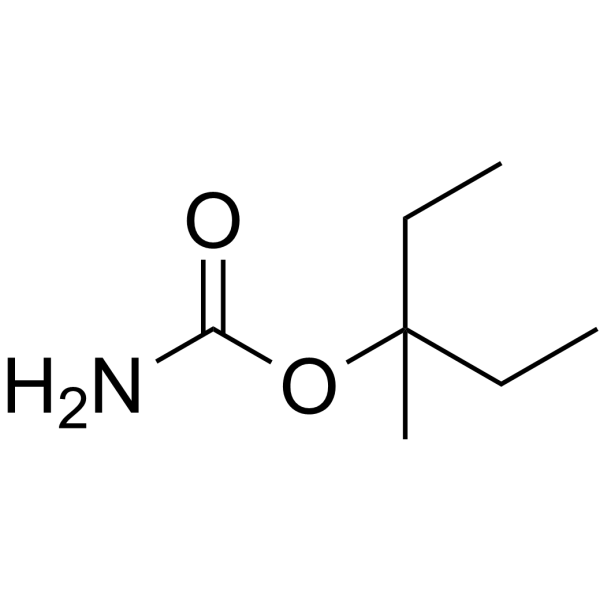
-
- HY-W052144S
-
-

-
- HY-B1343
-
-
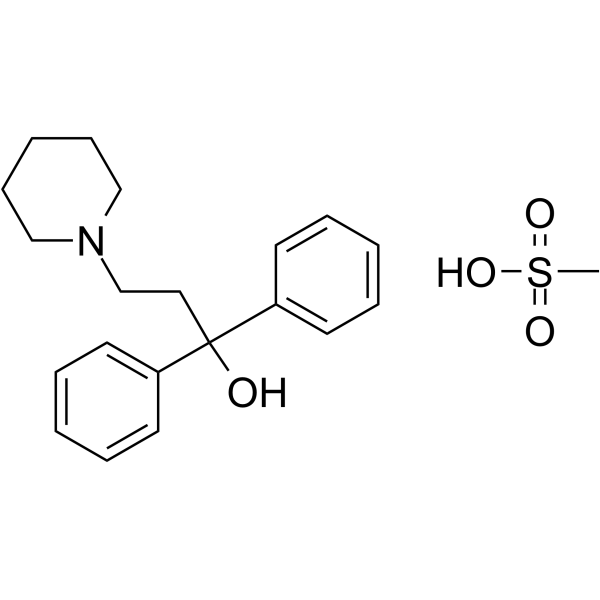
-
- HY-B1462
-
-
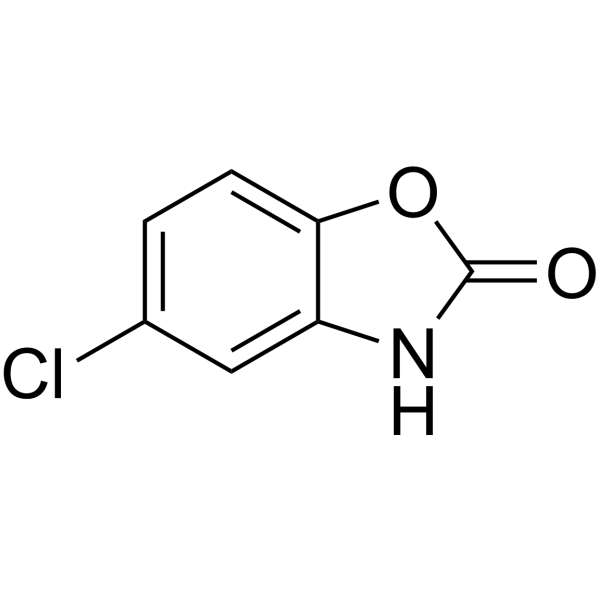
-
- HY-B0678
-
-
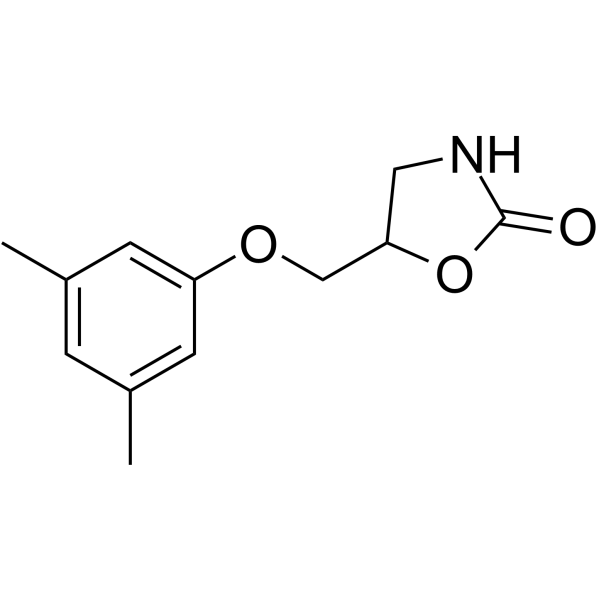
-
- HY-106888
-
|
|
Endogenous Metabolite
|
Neurological Disease
|
|
CS-722 Free base is a synthesized centrally acting muscle relaxant, and has a muscle relaxant activity and depressant effectson the spinal reflex . CS-722 Free base inhibits spontaneous inhibitory postsynaptic currents and excitatory postsynaptic currents in hippocampal cultures probably by an inhibition of both sodium and calcium currents .
|
-
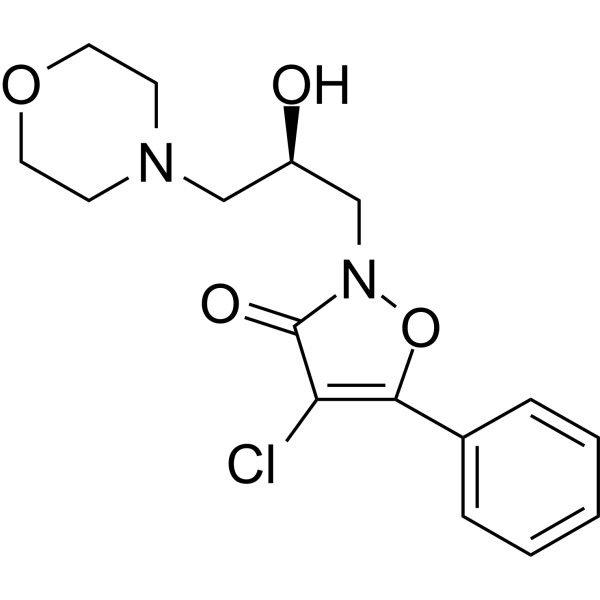
-
- HY-17033
-
|
Org-9426
|
Others
|
Neurological Disease
|
|
Rocuronium (Org-9426) is an aminosteroid non-depolarizing neuromuscular blocker or muscle relaxant used in modern anaesthesia.
|
-

-
- HY-B0353
-
|
|
GABA Receptor
|
Neurological Disease
|
|
Chlormezanone resembles benzodiazepine. The action of Chlormezanone is similar to benzodiazepine-type agents. Chlormezanone is used as an anxiolytic and a muscle relaxant.
|
-
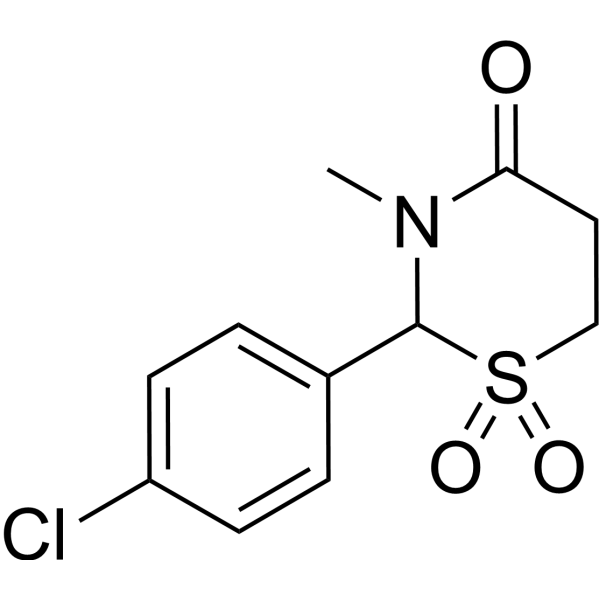
-
- HY-14895
-
|
CM346
|
Others
|
Neurological Disease
|
|
Fabomotizole (CM346) is an anxiolytic agent. Fabomotizole produces anxiolytic and neuroprotective effects without any muscle relaxant actions.
|
-
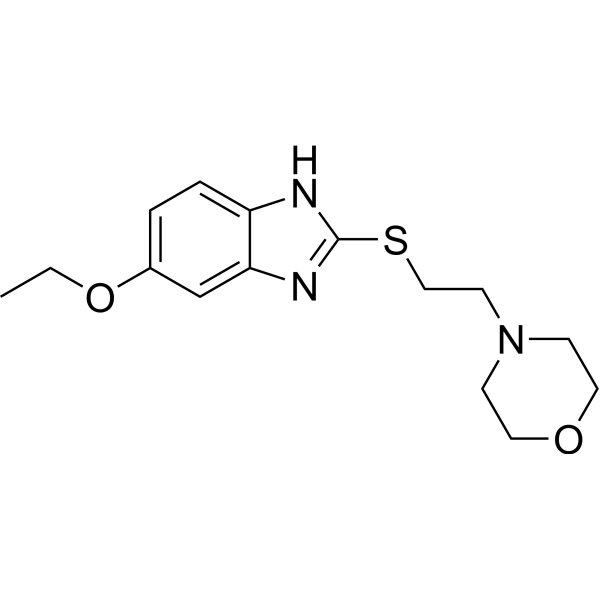
-
- HY-14895A
-
|
CM346 hydrochloride
|
Others
|
Neurological Disease
|
|
Fabomotizole hydrochloride (CM346 hydrochloride) is an anxiolytic agent. Fabomotizole hydrochloride produces anxiolytic and neuroprotective effects without any muscle relaxant actions.
|
-
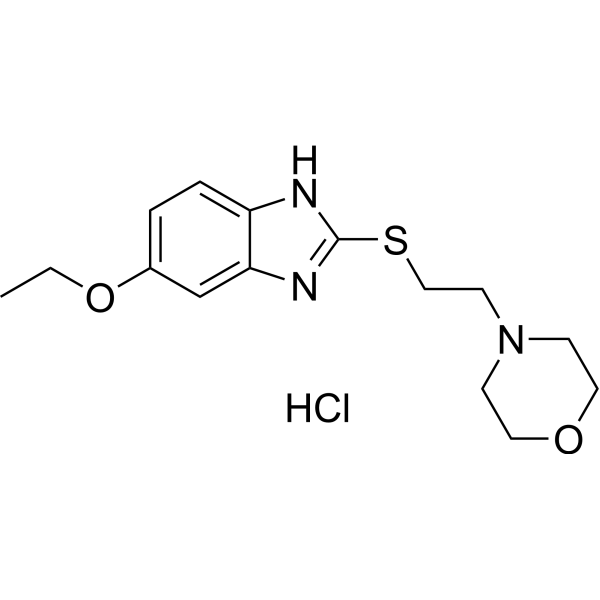
-
- HY-128469
-
|
|
GABA Receptor
|
Neurological Disease
|
|
Inaperisone is a centrally acting muscle relaxant. Inaperisone can inhibit the micturition reflex by acting indirectly on GABAB receptors in the brainstem .
|
-

-
- HY-B0740S
-
|
MK130-d3 (hydrochloride)
|
5-HT Receptor
|
Neurological Disease
|
|
Cyclobenzaprine-d3 (hydrochloride) is the deuterium labeled Cyclobenzaprine hydrochloride. Cyclobenzaprine hydrochloride (MK130 hydrochloride) is a skeletal muscle relaxant and a central nervous system (CNS) depressant.
|
-
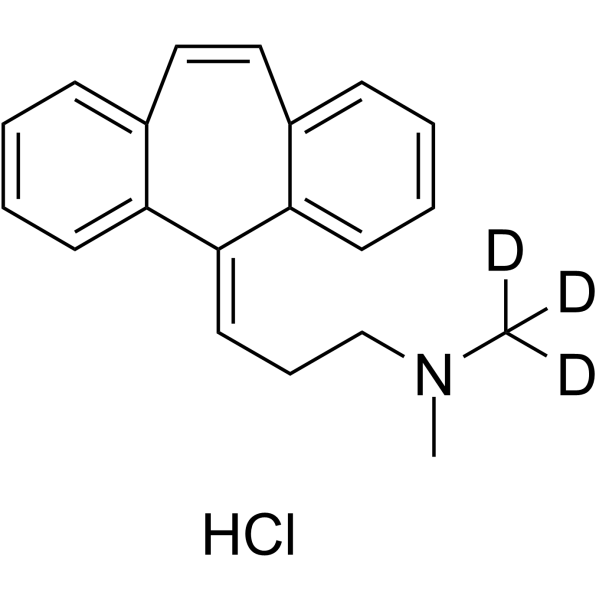
-
- HY-B0678S
-
-
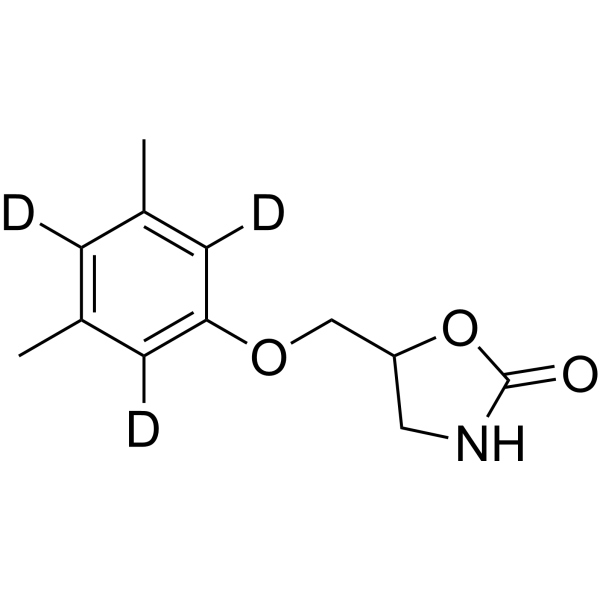
-
- HY-B0262S
-
|
|
Sodium Channel
|
Metabolic Disease
|
|
Methocarbamol-d5 is deuterium labeled Methocarbamol. Methocarbamol is an orally active central muscle relaxant and blocks muscular Nav1.4 channel[1].
|
-
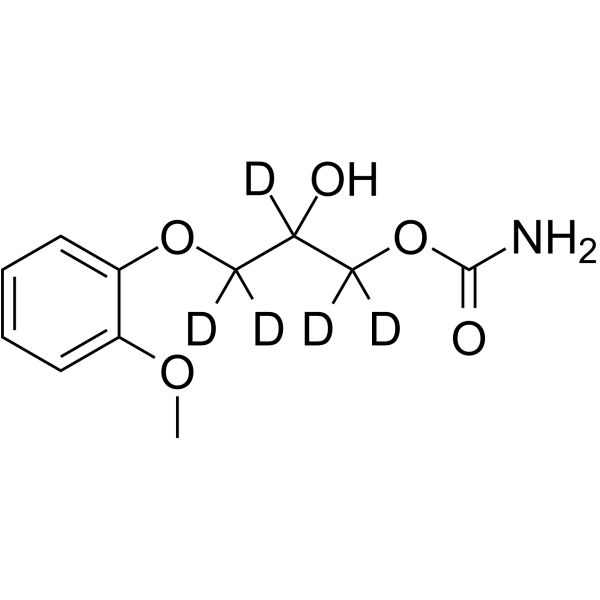
-
- HY-121966
-
|
Riparin III
|
Others
|
Cancer
|
|
Riparin is a nonspecific smooth muscle relaxant. Riparin inhibits CaCl2-induced contractions in a reversible and non-competitive manner and can be used in spasmolytic studies .
|
-

-
- HY-W016221
-
|
|
Drug Metabolite
|
Inflammation/Immunology
|
|
6-Hydroxy Chlorzoxazone is a metabolite of Chlorzoxazone (HY-B1462). Chlorzoxazone is a centrally acting muscle relaxant used to treat muscle spasm and the resulting pain or discomfort .
|
-
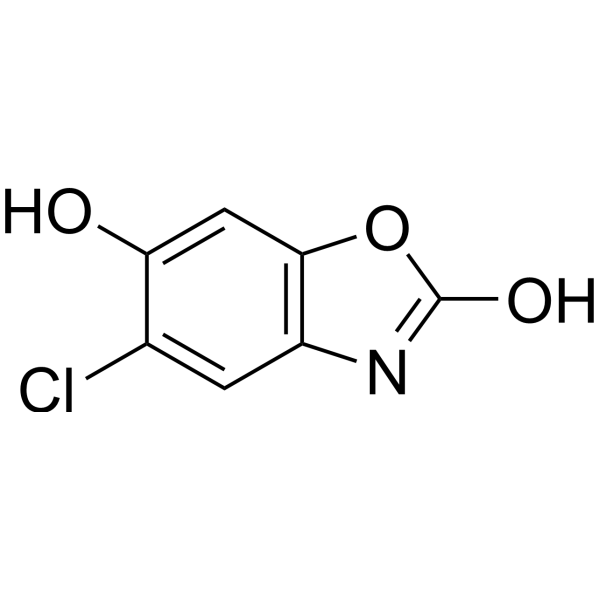
-
- HY-B1462S1
-
|
|
Cytochrome P450
|
Inflammation/Immunology
|
|
Chlorzoxazone- 13C is the 13C labeled Chlorzoxazone[1]. Chlorzoxazone is a centrally acting muscle relaxant used to treat muscle spasm and the resulting pain or discomfort[2].
|
-
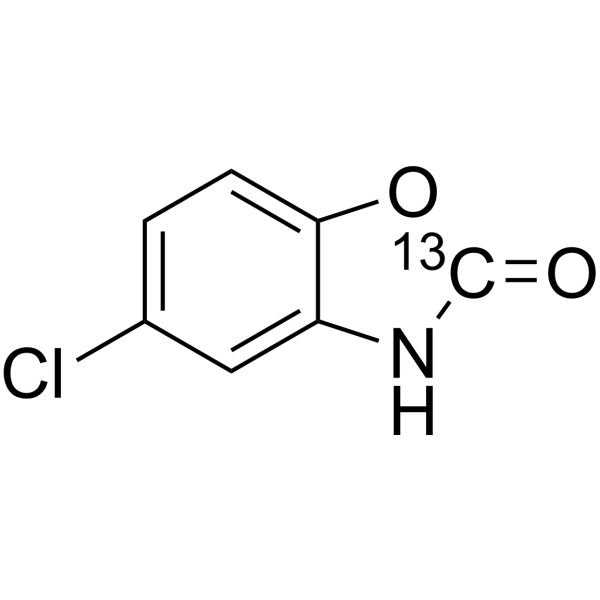
-
- HY-17440
-
|
ORG 9426 Bromide
|
nAChR
|
Neurological Disease
Cancer
|
|
Rocuronium Bromide (ORG 9426 Bromide) is an aminosteroid non-depolarizing neuromuscular blocker or muscle relaxant used in modern anaesthesia, to facilitate endotracheal intubation and to provide skeletal musclerelaxation during surgery or mechanical ventilation.
|
-
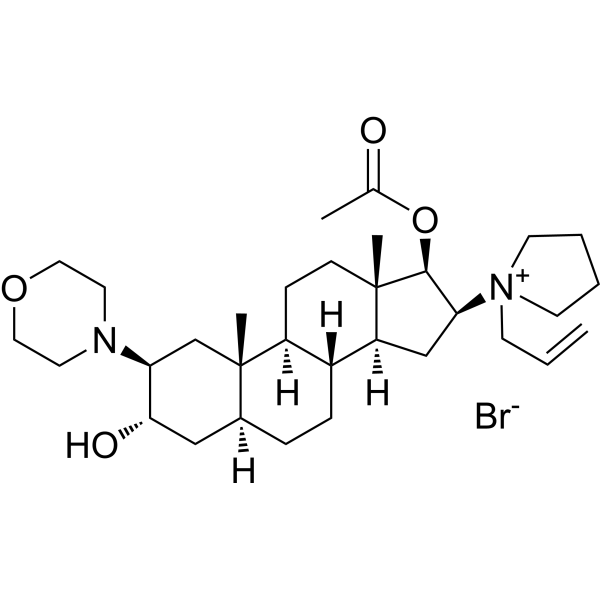
-
- HY-B0118A
-
|
ORG NC 45
|
nAChR
|
Neurological Disease
Cancer
|
|
Vecuronium (ORG NC 45) bromide is a non-depolarizing neuromuscular blocking agent that also acts as a nicotinic acetylcholine receptor (nAChR) inhibitor, a muscle relaxant, and can be used for pre-surgical anesthesia .
|
-

-
- HY-N2005
-
|
|
|
|
|
Cycleanine is a potent vascular selective Calcium antagonist. Cycleanine has analgesic, muscle relaxant and anti-inflammatory activities. Cycleanine has potential for anti-ovarian cancer acting through the apoptosis pathway .
|
-
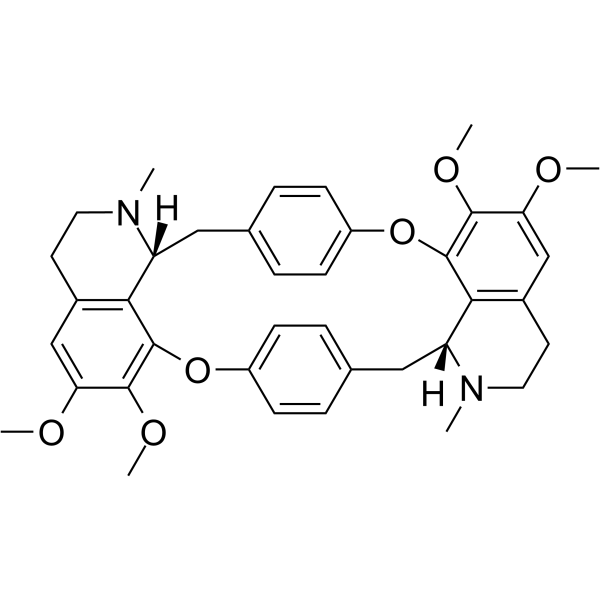
-
- HY-B0499A
-
|
Octylonium bromide; SP63
|
mAChR
|
Neurological Disease
|
|
Otilonium bromide (OB) is an orally active mAChR inhibitor and smooth muscle relaxant which can interfere with the mobilization of calcium in intestinal smooth muscle, OB can be used for research of irritable bowel syndrome .
|
-
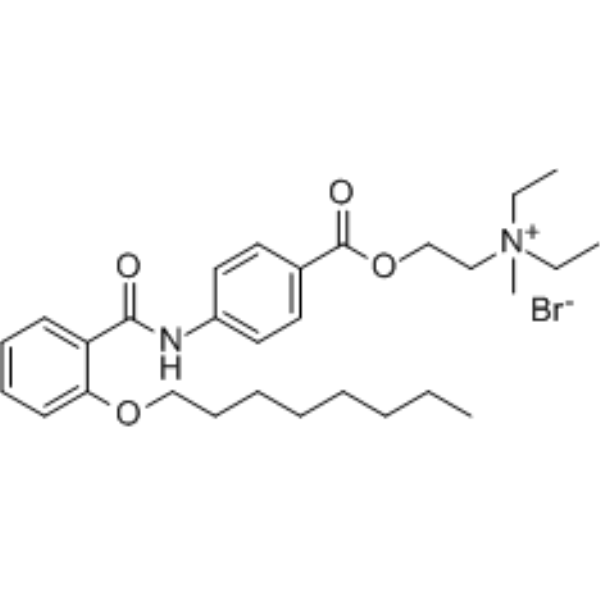
-
- HY-113920A
-
|
EU4093 free base
|
Calcium Channel
|
Metabolic Disease
|
|
Azumolene (EU4093 free base), a Dantrolene analog, is a muscle relaxant. Azumolene is a ryanodine receptor (RyR) modulator and inhibits the calcium-release through ryanodine receptor. Azumolene can be used for malignant hyperthermia research .
|
-
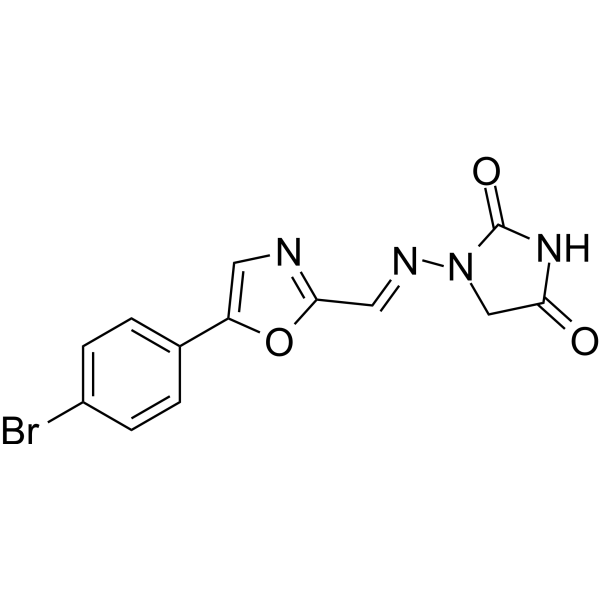
-
- HY-N0301
-
|
|
GABA Receptor
|
Neurological Disease
Inflammation/Immunology
|
|
Thiocolchicoside is a competitive γ-aminobutyric acid type A (GABAA) receptor antagonist and glycine receptor agonist in the central nervous system. Thiocolchicoside is a semisynthetic sulfur derivative of colchicoside. Thiocolchicoside is a muscle relaxant and has anti-inflammatory, and analgesic properties .
|
-

-
- HY-B1700A
-
|
|
nAChR
|
Neurological Disease
|
|
Mivacurium dichloride is a benzylisoquinoline derivative and is a short-acting non-depolarizing neuromuscular blocking agent and skeletal muscle relaxant. Mivacurium dichloride couples with the nAChR to reduce or inhibit the depolarizing effect of acetylcholine on the terminal disc of the muscle cell .
|
-
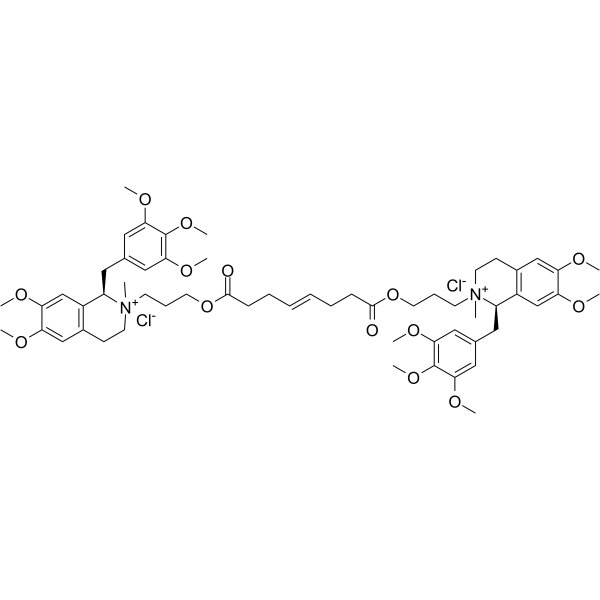
-
- HY-B1139
-
|
|
Apoptosis
|
Neurological Disease
|
|
Tolperisone hydrochloride is a centrally acting muscle relaxant studied in neurological disorders causing pathological rhabdomyosclerosis (pyramidal tract injury, multiple sclerosis, myelopathy, encephalomyelitis), spastic paralysis, and other muscle dystonia-related Encephalopathy. Tolperisone hydrochloride also has antiviral activity .
|
-
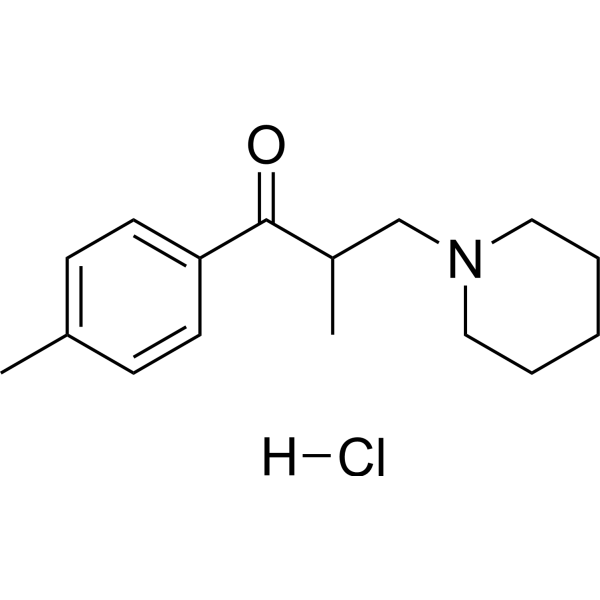
-
- HY-124047
-
|
|
Cholinesterase (ChE)
|
Neurological Disease
|
|
RX 67668 is a potent cholinesterase inhibitor with an IC50 of 5 μM for both acetylcholinesterase (AChE) and butyrylcholinesterase. RX 67668 can reverse the neuromuscular blockade induced by D-tubocurarine. RX 67668 is a muscle relaxant used to relieve skeletal muscle fatigue .
|
-
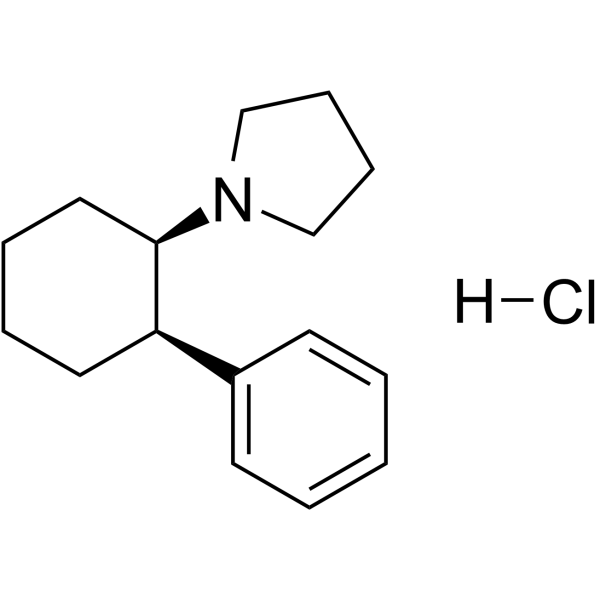
-
- HY-107944
-
|
Maolate; U 19646
|
Others
|
Neurological Disease
|
|
Chlorphenesin carbamate is a centrally acting skeletal muscle relaxant. Chlorphenesin carbamate can be used for the research of pain and discomfort related to skeletal muscle trauma and inflammation . Chlorphenesin carbamate is a selective blocker of polysynaptic pathways at the spinal and supra-spinal levels . Antinociceptive effect .
|
-
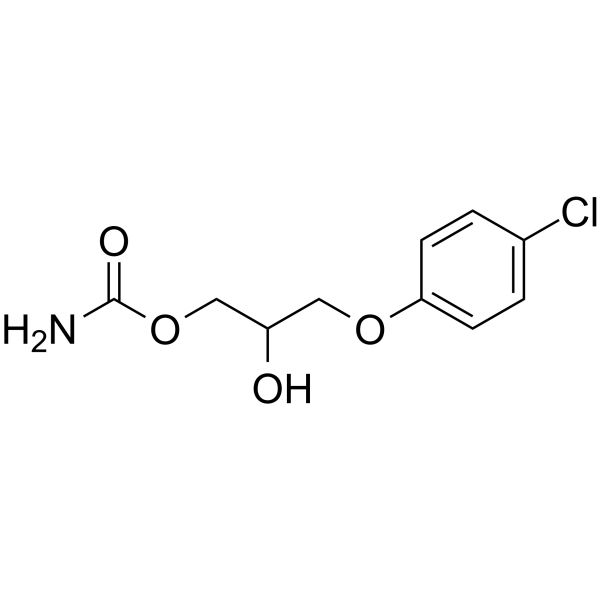
-
- HY-B0262
-
|
|
Sodium Channel
|
Neurological Disease
|
|
Methocarbamol is an orally active central muscle relaxant and blocks muscular Nav1.4 channel. Methocarbamol reversibly affects voltage dependence of inactivation of Nav1.4 channel. Methocarbamol has the potential for muscle spasms and pain syndromes research .
|
-
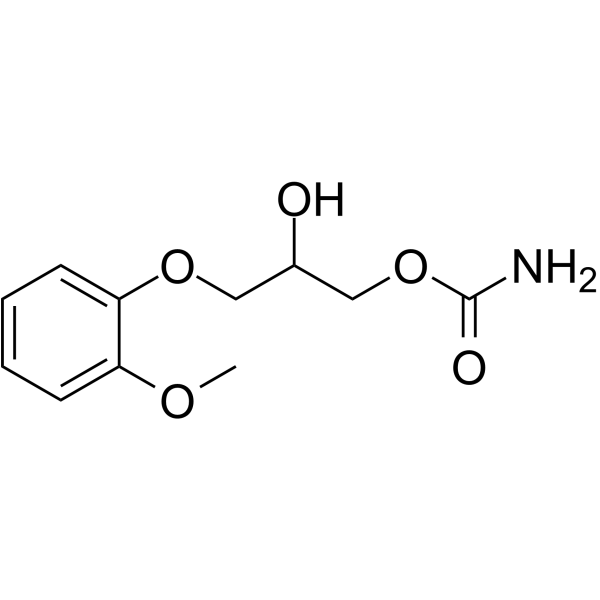
-
- HY-100822A
-
|
(-)-HA 966
|
|
|
|
(S)-(-)-HA 966 ((-)-HA 966), a γ-Hydroxybutyrate-like agent, is weakly active as an NMDA-receptor antagonist. (S)-(-)-HA 966 possesses muscle relaxant action and prevents enhanced mesocorticolimbic dopamine metabolism and behavioral correlates of restraint stress, conditioned fear .
|
-
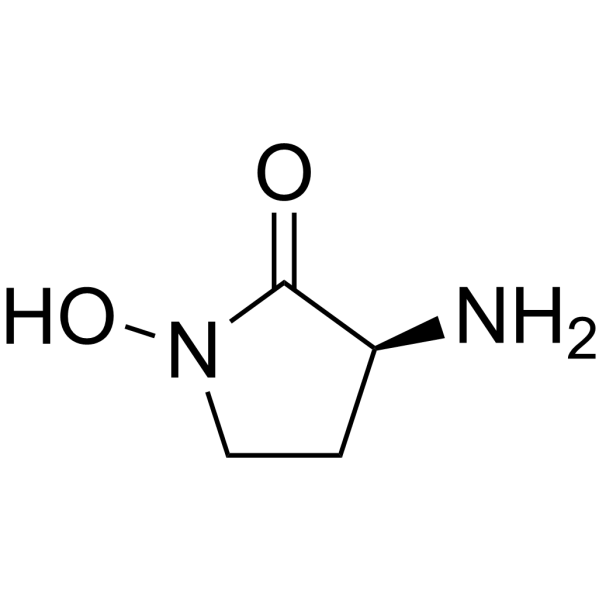
-
- HY-17440R
-
|
ORG 9426 Bromide (Standard)
|
nAChR
|
Neurological Disease
Cancer
|
|
Rocuronium (Bromide) (Standard) is the analytical standard of Rocuronium (Bromide). This product is intended for research and analytical applications. Rocuronium Bromide (ORG 9426 Bromide) is an aminosteroid non-depolarizing neuromuscular blocker or muscle relaxant used in modern anaesthesia, to facilitate endotracheal intubation and to provide skeletal musclerelaxation during surgery or mechanical ventilation.
|
-

-
- HY-B1139S
-
|
|
Isotope-Labeled Compounds
|
Neurological Disease
|
|
Tolperisone-d10 (hydrochloride) is the deuterium labeled Tolperisone hydrochloride. Tolperisone hydrochloride is a centrally acting muscle relaxant, is indicated for use in the treatment of pathologically increased tone of the cross-striated muscle caused by neurological diseases (damage of the pyramidal tract, multiple sclerosis, myelopathy, encephalomyelitis) and of spastic paralysis and other encephalopathies manifested with muscular dystonia.
|
-
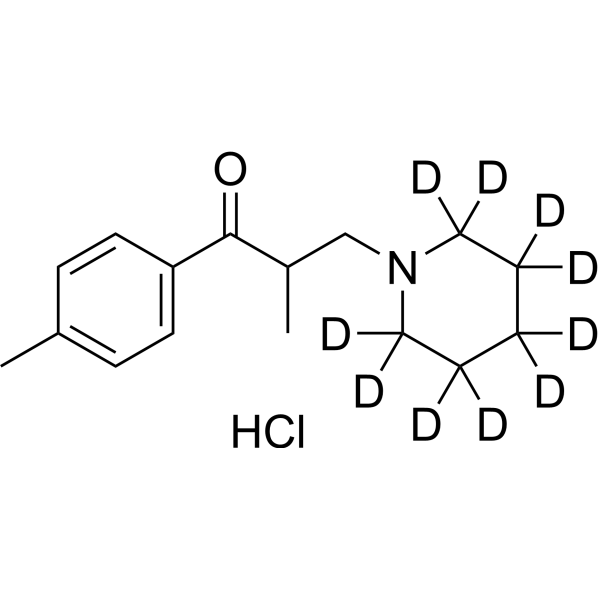
-
- HY-133797
-
|
|
Drug Metabolite
|
Neurological Disease
|
|
Cyclobenzaprine N-oxide is the tertiary amine metabolite of Cyclobenzaprine (HY-B0740) in liver particles. Cyclobenzaprine is a skeletal muscle relaxant and is active on the central nervous system. The liver cytosol from liver particles has reductase activity that can reduce Cyclobenzaprine N-oxide to the corresponding amine .
|
-
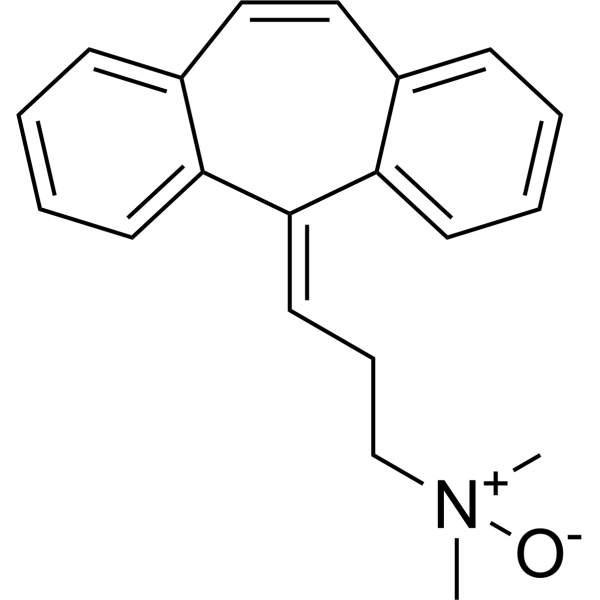
-
- HY-116226
-
|
|
Drug Metabolite
|
Neurological Disease
Endocrinology
|
|
4-Hydroxy xylazine (Compound M2) is a metabolized product of hydroxylated xylazine (HY-B0443). Xylazine is a highly effective α2-adrenergic agonist used as a muscle relaxant in veterinary medicine and can be used in research to promote sedation and relieve pain .
|
-
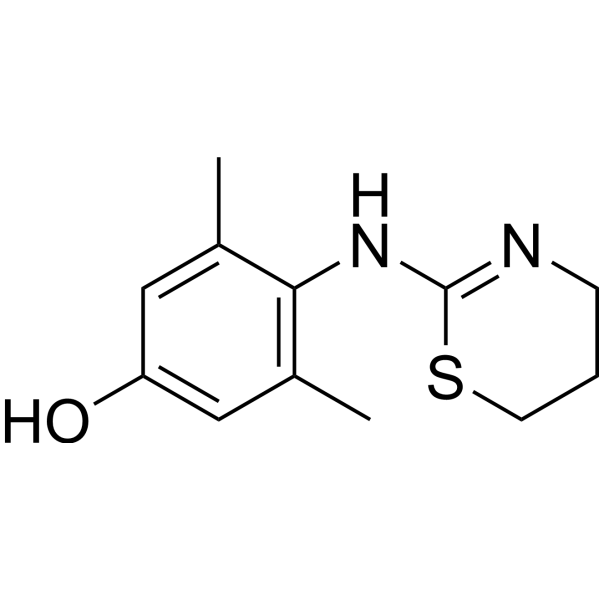
-
- HY-149554
-
|
Bimatoprost dimethyl amide
|
Others
|
Neurological Disease
|
|
17-Phenyl trinor Prostaglandin F2α dimethyl amide (Bimatoprost dimethyl amide), a 1-OH cyclopentane heptanoic acid, 2-(cycloalkyl or arylalkyl) derivative, is a smooth muscle relaxant. 17-Phenyl trinor Prostaglandin F2α dimethyl amide has the potential for glaucoma research .
|
-

-
- HY-B0262S1
-
|
|
Sodium Channel
|
Neurological Disease
|
|
Methocarbamol-d3 is the deuterium labeled Methocarbamol. Methocarbamol is an orally active central muscle relaxant and blocks muscular Nav1.4 channel. Methocarbamol reversibly affects voltage dependence of inactivation of Nav1.4 channel. Methocarbamol has the potential for muscle spasms and pain syndromes research[1][2][3].
|
-
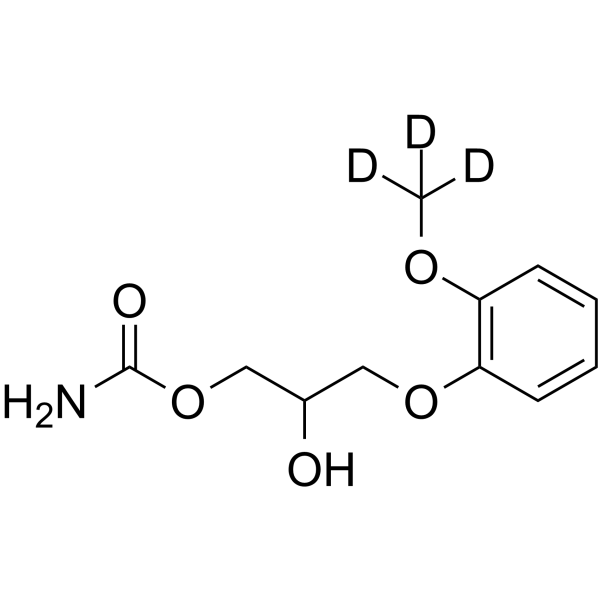
-
- HY-128891
-
|
|
Others
|
Neurological Disease
|
|
Eperisone is an antispastic agent used for treatment of diseases characterized by muscle stiffness and pain. It works by relaxing both skeletal muscles and vascularsmooth muscles, thus demonstrating avariety of effects such as reduction ofmyotonia, improvement of circulationand suppression of the pain reflex. Eperisone is a centrally acting muscle relaxant inhibiting the pain reflex pathway, having a vasodilator effect [2 .
|
-
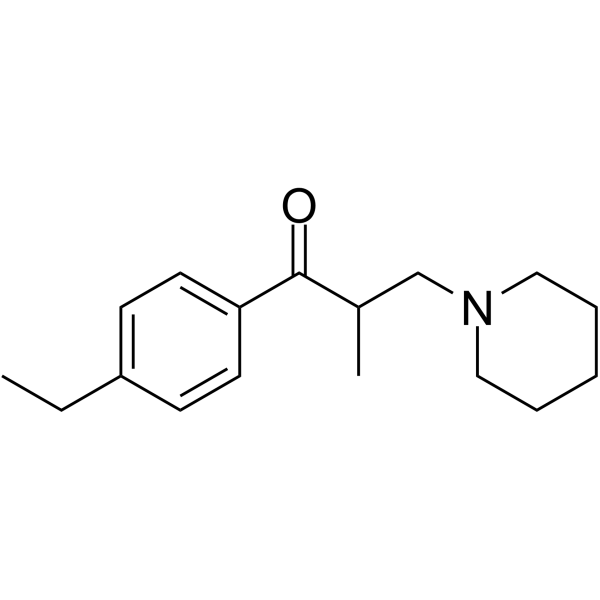
-
- HY-B1901
-
|
(±)-Eperisone hydrochloride
|
|
|
|
Eperisone Hydrochloride ((±)-Eperisone hydrochloride) is an antispastic agent used for treatment of diseases characterized by muscle stiffness and pain. It works by relaxing both skeletal muscles and vascularsmooth muscles, thus demonstrating avariety of effects such as reduction ofmyotonia, improvement of circulationand suppression of the pain reflex. Eperisone Hydrochloride ((±)-Eperisone hydrochloride) is a centrally acting muscle relaxant inhibiting the pain reflex pathway, having a vasodilator effect [2 .
|
-

-
- HY-B1462S
-
|
|
Cytochrome P450
|
Inflammation/Immunology
|
|
Chlorzoxazone-d3 is the deuterium labeled Chlorzoxazone. Chlorzoxazone is a centrally acting muscle relaxant used to treat muscle spasm and the resulting pain or discomfort. It acts on the spinal cord by depressing reflexes.Chlorzoxazone is currently being used as a marker substrate in vitro/vivo studies to quantify cytochrome P450 2E1 (CYP2E1) activity in humans.
|
-

-
- HY-12542
-
Dantrolene
Maximum Cited Publications
7 Publications Verification
F 368
|
Calcium Channel
Autophagy
|
Neurological Disease
Inflammation/Immunology
|
|
Dantrolene is an orally active, non-competitive glutathione reductase inhibitor with a Ki of 111.6 μM and an IC50 of 52.3 μM. Dantrolene is a ryanodine receptor (RyR) antagonist and Ca2+ signaling stabilizer. Dantrolene is a direct-acting skeletal muscle relaxant. Dantrolene can be used for the research of muscle spasticity, malignant hyperthermia, Huntington's disease and other neuroleptic malignant syndrome .
|
-
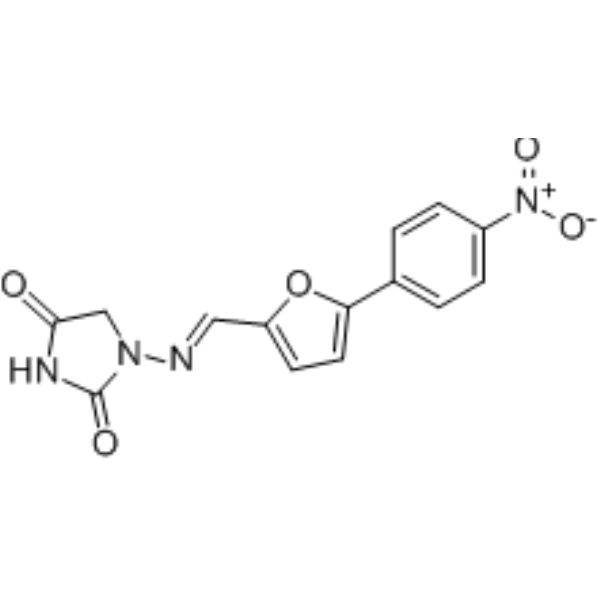
-
- HY-B0262S2
-
|
|
Isotope-Labeled Compounds
Sodium Channel
|
Neurological Disease
|
|
Methocarbamol- 13C,d3 is the 13C- and deuterium labeled Methocarbamol. Methocarbamol is an orally active central muscle relaxant and blocks muscular Nav1.4 channel. Methocarbamol reversibly affects voltage dependence of inactivation of Nav1.4 channel. Methocarbamol has the potential for muscle spasms and pain syndromes research[1][2][3].
|
-
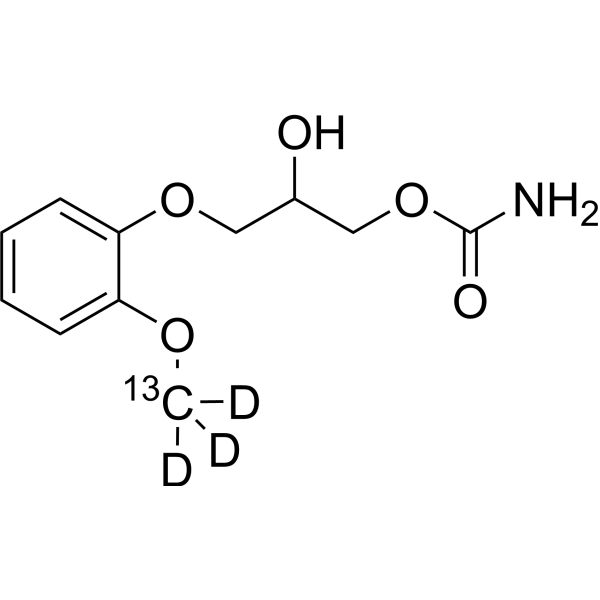
-
- HY-12542A
-
|
Dantrolene sodium hydrate
|
Calcium Channel
Autophagy
|
Others
|
|
Dantrolene sodium hemiheptahydrate is an orally active, non-competitive glutathione reductase inhibitor with a Ki of 111.6 μM and an IC50 of 52.3 μM. Dantrolene sodium hemiheptahydrate is a ryanodine receptor (RyR) antagonist and Ca2+ signaling stabilizer. Dantrolene sodium hemiheptahydrate is a direct-acting skeletal muscle relaxant. Dantrolene sodium hemiheptahydrate can be used for the research of muscle spasticity, malignant hyperthermia, Huntington's disease and other neuroleptic malignant syndrome .
|
-
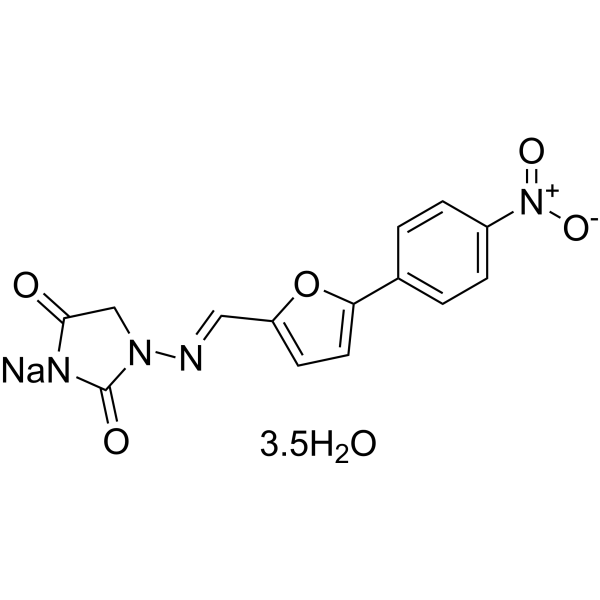
-
- HY-12542S
-
|
F 368-13C3
|
Isotope-Labeled Compounds
Glutathione Reductase
|
Neurological Disease
Inflammation/Immunology
|
|
Dantrolene- 13C3 is the 13C3 labeled Dantrolene. Dantrolene (F368), a muscle relaxant, non-competitively inhibits human erythrocyte glutathione reductase. Ki and IC50 values are 111.6 μM and 52.3 μM, respectively. Dantrolene is a ryanodine receptor antagonist and Ca2+ signaling stabilizer. Dantrolene can be used for the research of muscle spasticity, malignant hyperthermia, Huntington's disease and other neuroleptic malignant syndrome.
|
-

-
- HY-B1901S
-
|
|
Isotope-Labeled Compounds
|
Neurological Disease
|
|
Eperisone-d10 (hydrochloride) is the deuterium labeled Eperisone hydrochloride. Eperisone Hydrochloride ((±)-Eperisone hydrochloride) is an antispastic agent used for treatment of diseases characterized by muscle stiffness and pain. It works by relaxing both skeletal muscles and vascularsmooth muscles, thus demonstrating avariety of effects such as reduction ofmyotonia, improvement of circulationand suppression of the pain reflex. Eperisone Hydrochloride ((±)-Eperisone hydrochloride) is a centrally acting muscle relaxant inhibiting the pain reflex pathway, having a vasodilator effect[1][2 [3].
|
-
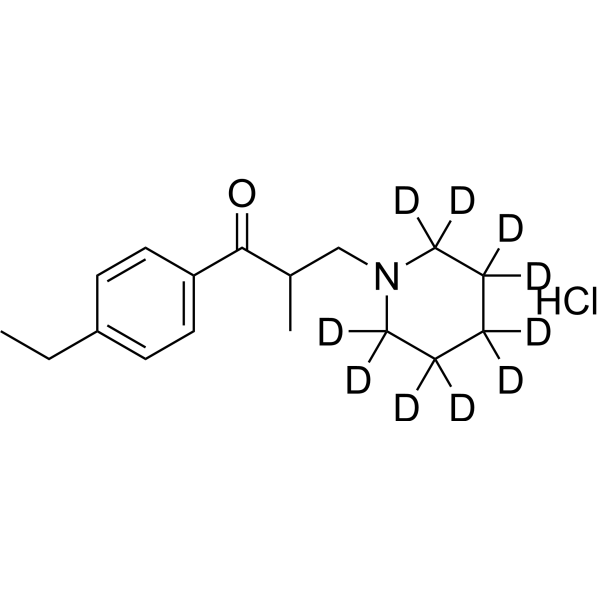
-
- HY-110289
-
|
|
Serotonin Transporter
5-HT Receptor
|
Neurological Disease
|
|
(R)-Citalopram oxalate is an anticonvulsant, antidepressant and muscle relaxant. (R)-Citalopram oxalate is at least 20-fold weaker than S-citalopram (Escitalopram; HY-14258) as inhibitor of the 5-HT transporter (SERT). (R)-Citalopram oxalate functionally antagonises S-citalopram in vivo and in vitro. (R)-Citalopram oxalate has an effect on the association of Escitalopram with the high affinity primary site, and on its dissociation from the 5-HT transporter, via an allosteric mechanism .
|
-
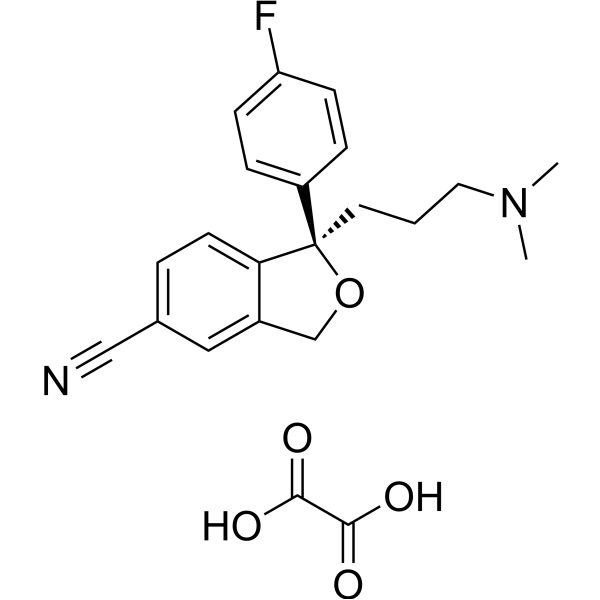
- HY-B1833
-
|
HQ-495
|
GABA Receptor
|
Neurological Disease
|
|
Afloqualone (HQ-495) is a GABAergic agent and has agonist activity at the β subtype of the GABAα receptor. Afloqualone has antivertiginous effects thought to be attributable to the increased sensitivity of GABA receptors of the LVN neuron site .
|
-
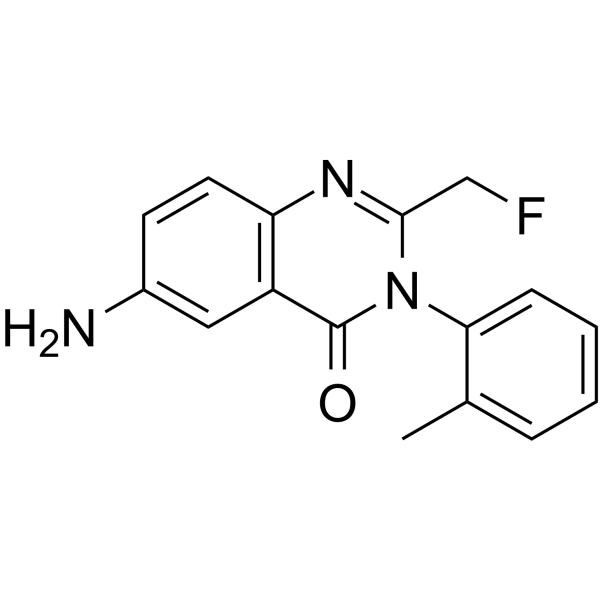
- HY-157959
-
|
(±)-Orphenadrine
|
iGluR
Cytochrome P450
Cholinesterase (ChE)
|
Neurological Disease
Cancer
|
|
Orphenadrine ((±)-Orphenadrine) is a skeletal muscle relaxant and NMDA antagonist that also has antiparkinsonian, antihistamine, antitremor, antispasmodic, and analgesic effects. Orphenadrine inhibits the binding of [3H]MK-801 to the phencyclidine (PCP) binding site of the NMDA receptor. Orphenadrine is also an anticholinergic and cytochrome P450 (CYP) 2B inducer. Orphenadrine may exert pro-tumor effects, causing CAR nuclear translocation, resulting in microsomal reactive oxygen species (ROS) production and oxidative stress. Orphenadrine also exerts neuronal protection, protecting rat cerebellar granule cells (CGC) from 3-NPA-induced death and has inhibitory potential against neurodegenerative diseases mediated by NMDA receptor overactivation .
|
-
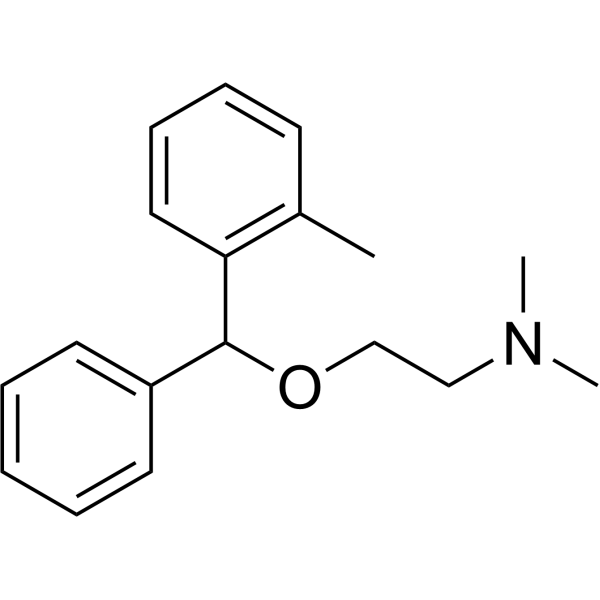
| Cat. No. |
Product Name |
Category |
Target |
Chemical Structure |
| Cat. No. |
Product Name |
Chemical Structure |
-
- HY-B0678S
-
|
|
|
Metaxalone-d3 is the deuterium labeled Metaxalone. Metaxalone (AHR438;NSC170959) is a muscle relaxant used to relax muscles.
|
-

-
- HY-W052144S
-
|
|
|
(±) Anabasine-d4 (dihydrochloride) is deuterium labeled (±) Anabasine. (±) Anabasine is a biphasic muscle relaxant.
|
-

-
- HY-B0740S
-
|
|
|
Cyclobenzaprine-d3 (hydrochloride) is the deuterium labeled Cyclobenzaprine hydrochloride. Cyclobenzaprine hydrochloride (MK130 hydrochloride) is a skeletal muscle relaxant and a central nervous system (CNS) depressant.
|
-

-
- HY-B0262S
-
|
|
|
Methocarbamol-d5 is deuterium labeled Methocarbamol. Methocarbamol is an orally active central muscle relaxant and blocks muscular Nav1.4 channel[1].
|
-

-
- HY-B1462S1
-
|
|
|
Chlorzoxazone- 13C is the 13C labeled Chlorzoxazone[1]. Chlorzoxazone is a centrally acting muscle relaxant used to treat muscle spasm and the resulting pain or discomfort[2].
|
-

-
- HY-B1139S
-
|
|
|
Tolperisone-d10 (hydrochloride) is the deuterium labeled Tolperisone hydrochloride. Tolperisone hydrochloride is a centrally acting muscle relaxant, is indicated for use in the treatment of pathologically increased tone of the cross-striated muscle caused by neurological diseases (damage of the pyramidal tract, multiple sclerosis, myelopathy, encephalomyelitis) and of spastic paralysis and other encephalopathies manifested with muscular dystonia.
|
-

-
- HY-B0262S1
-
|
|
|
Methocarbamol-d3 is the deuterium labeled Methocarbamol. Methocarbamol is an orally active central muscle relaxant and blocks muscular Nav1.4 channel. Methocarbamol reversibly affects voltage dependence of inactivation of Nav1.4 channel. Methocarbamol has the potential for muscle spasms and pain syndromes research[1][2][3].
|
-

-
- HY-B1462S
-
|
|
|
Chlorzoxazone-d3 is the deuterium labeled Chlorzoxazone. Chlorzoxazone is a centrally acting muscle relaxant used to treat muscle spasm and the resulting pain or discomfort. It acts on the spinal cord by depressing reflexes.Chlorzoxazone is currently being used as a marker substrate in vitro/vivo studies to quantify cytochrome P450 2E1 (CYP2E1) activity in humans.
|
-

-
- HY-B0262S2
-
|
|
|
Methocarbamol- 13C,d3 is the 13C- and deuterium labeled Methocarbamol. Methocarbamol is an orally active central muscle relaxant and blocks muscular Nav1.4 channel. Methocarbamol reversibly affects voltage dependence of inactivation of Nav1.4 channel. Methocarbamol has the potential for muscle spasms and pain syndromes research[1][2][3].
|
-

-
- HY-12542S
-
|
|
|
Dantrolene- 13C3 is the 13C3 labeled Dantrolene. Dantrolene (F368), a muscle relaxant, non-competitively inhibits human erythrocyte glutathione reductase. Ki and IC50 values are 111.6 μM and 52.3 μM, respectively. Dantrolene is a ryanodine receptor antagonist and Ca2+ signaling stabilizer. Dantrolene can be used for the research of muscle spasticity, malignant hyperthermia, Huntington's disease and other neuroleptic malignant syndrome.
|
-

-
- HY-B1901S
-
|
|
|
Eperisone-d10 (hydrochloride) is the deuterium labeled Eperisone hydrochloride. Eperisone Hydrochloride ((±)-Eperisone hydrochloride) is an antispastic agent used for treatment of diseases characterized by muscle stiffness and pain. It works by relaxing both skeletal muscles and vascularsmooth muscles, thus demonstrating avariety of effects such as reduction ofmyotonia, improvement of circulationand suppression of the pain reflex. Eperisone Hydrochloride ((±)-Eperisone hydrochloride) is a centrally acting muscle relaxant inhibiting the pain reflex pathway, having a vasodilator effect[1][2 [3].
|
-

Your information is safe with us. * Required Fields.
Inquiry Information
- Product Name:
- Cat. No.:
- Quantity:
- MCE Japan Authorized Agent:




























































